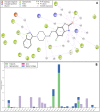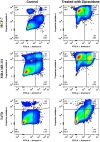In-silico and in-vitro study reveals ziprasidone as a potential aromatase inhibitor against breast carcinoma
- PMID: 37783782
- PMCID: PMC10545834
- DOI: 10.1038/s41598-023-43789-1
In-silico and in-vitro study reveals ziprasidone as a potential aromatase inhibitor against breast carcinoma
Abstract
Aromatase enzyme plays a fundamental role in the development of estrogen receptors, and due to this functionality, the enzyme has gained significant attention as a therapeutic for reproductive disorders and cancer diseases. The currently employed aromatase inhibitors have severe side effects whereas our novel aromatase inhibitor is more selective and less toxic, therefore has greater potential to be developed as a drug. The research framework of this study is to identify a potent inhibitor for the aromatase target by profiling molecular descriptors of the ligand and to find a functional pocket in the target by docking and MD simulations. For assessing cellular and metabolic activities as indicators of cell viability and cytotoxicity, in-vitro studies were performed by using the colorimetric MTT assay. Aromatase activities were determined by a fluorometric method. Cell morphology was assessed by phase-contrast light microscopy. Flow cytometry and Annexin V-FITC/PI staining assay determined cell cycle distribution and apoptosis. This study reports that CHEMBL708 (Ziprasidone) is the most promising compound that showed excellent aromatase inhibitory activity. By using better drug design methods and experimental studies, our study identified a novel compound that could be effective as a high-potential drug candidate against aromatase enzyme. We conclude that the compound ziprasidone effectively blocks the cell cycle at the G1-S phase and induces cancer cell death. Further, in-vivo studies are vital for developing ziprasidone as an anticancer agent. Lastly, our research outcomes based on the results of the in-silico experiments may pave the way for identifying effective drug candidates for therapeutic use in breast cancer.
© 2023. Springer Nature Limited.
Conflict of interest statement
The authors declare no competing interests.
Figures










References
Publication types
MeSH terms
Substances
LinkOut - more resources
Full Text Sources
Medical
Research Materials
Miscellaneous

